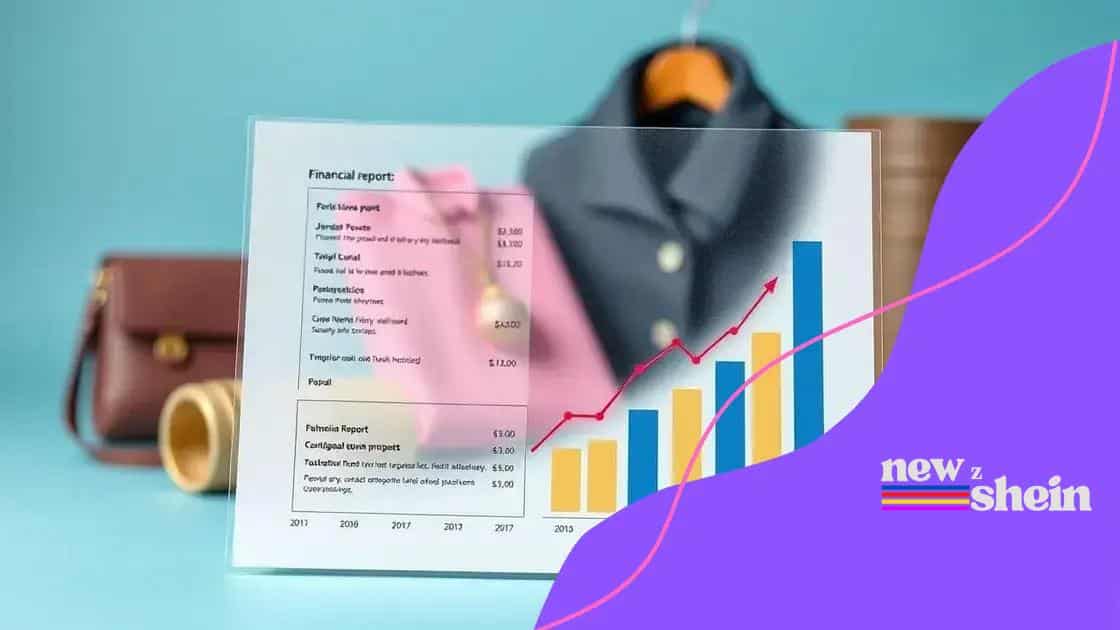Shein’s financial transparency initiatives are changing the game

Shein’s financial transparency initiatives focus on openly sharing financial data and practices, enhancing consumer trust and accountability while addressing challenges in supply chain management and data accuracy.
Shein’s financial transparency initiatives are shaking up the fashion industry. Ever wondered how this affects your shopping experience? Let’s dive into what transparency means for consumers and the brand.
Understanding Shein’s financial transparency approach
Understanding Shein’s financial transparency approach is essential for consumers who want to make informed choices. Shein’s commitment to transparency can change how we view fast fashion. It’s not just about the clothes; it’s about how they’re made and where the money goes.
What is Financial Transparency?
Financial transparency means that companies openly share information about their finances. This includes how they earn and spend money. Companies like Shein are starting to embrace this concept to build trust. By showing their financial details, they aim to be accountable to the customers.
Why is this important? Transparency allows consumers to feel confident when they shop. It ensures that companies are not hiding any concerning practices, such as unfair wages or unethical sourcing. When consumers are informed, they can make better choices.
Benefits of Shein’s Approach
Shein’s financial transparency comes with several benefits:
- Consumers gain a clearer understanding of product pricing.
- It fosters trust between Shein and its customers.
- Encourages ethical practices within the industry.
- Sets a standard for other retailers to follow.
When consumers can see where their money goes, it encourages better practices. Shein is leading the way by prioritizing this openness. It’s a shift that could influence the entire fashion industry.
Furthermore, being transparent can attract new customers. Shoppers today care about more than just style; they want to know they are supporting responsible businesses. This is why Shein’s initiative is not just beneficial for consumers, but also for themselves.
Comparing Transparency Among Competitors
Looking at how Shein measures up against its competitors helps us understand its importance further. Many brands have struggled with transparency, but Shein is taking steps to improve. By providing details regularly, they are setting themselves apart.
Through these practices, they challenge the status quo. It’s not only about selling clothes but also about shaping the future of the industry. Brands that follow Shein’s example can contribute to a more ethical marketplace.
Key benefits of financial transparency for consumers
Understanding the key benefits of financial transparency for consumers is vital in today’s market. When companies like Shein share their financial practices, it creates a positive ripple effect that enhances consumer trust. This transparency helps shoppers make informed choices about where they spend their money.
Enhanced Trust
One of the greatest benefits is the increase in trust. Customers feel more secure knowing that brands like Shein are open about their financial dealings. This openness reduces skepticism. Consumers are more likely to choose brands they trust.
Better Decision Making
When consumers have access to financial information, it enables better decision-making. Knowing the prices of production and profit margins can help consumers understand why certain items cost what they do. This information empowers them to support businesses that align with their values.
- Informed spending habits can lead to more ethical choices.
- Shoppers are more likely to support fair trade practices.
- Consumers can evaluate if a company pays fair wages.
- Understanding brand profitability can guide ethical shopping.
Importantly, consumers benefit from knowing how brands manage their profits. If a company allocates funds toward sustainable practices, it’s an attractive quality for conscious buyers. It can motivate shoppers to favor brands that prioritize the planet and ethical treatment of workers.
Furthermore, increased financial transparency can lead to healthier competition among brands. When companies reveal their operations, it encourages others to follow suit. This push for openness can raise industry standards, ultimately benefiting consumers even more.
Increased Accountability
As consumers demand transparency, companies become more accountable. This accountability often results in positive changes. For instance, brands may strive to cut costs responsibly or improve labor conditions. These adjustments arise from the expectation of accountability that comes from transparency.
Moreover, when shoppers feel that a company takes responsibility for its practices, it leads to loyalty. Engaged customers who trust brands often return for future purchases. This loyalty can be critical in a competitive market.
How Shein compares with competitors in transparency

Understanding how Shein compares with competitors in transparency is essential for consumers looking for ethical brands. In the fast-paced fashion world, transparency can set a company apart. While many brands focus on providing stylish products, fewer prioritize openly sharing financial practices.
Shein’s Unique Approach
Shein has taken notable steps towards transparency by regularly disclosing information related to its supply chain. This sets it apart from many traditional retailers. By publishing insights about their sourcing and production costs, they aim to foster trust with their customers. The brand’s commitment to transparency gives consumers a clearer picture of their practices.
Comparison with Other Brands
When we compare Shein to other fashion retailers, several differences stand out:
- Some brands provide minimal information about their production costs.
- Others may share environmental practices but avoid discussing financials.
- Many competitors do not regularly update financial or operational details.
- Shein actively engages with its audience to promote transparency.
This active engagement helps Shein establish itself as a leader in transparency, a quality consumers increasingly value. In contrast, many competitors fall short, missing out on consumer trust and loyalty.
Consumer Reactions
Consumers are noticing these differences. Transparency is becoming a deciding factor for many. Brands that fail to disclose important information might struggle to attract ethical consumers. Shein’s efforts position it favorably in an increasingly conscious marketplace.
Moreover, Shein’s vibrant marketing campaigns often highlight its transparency initiatives. This emphasis reinforces the idea that the brand cares about more than just profit; it cares about the impact it has on the world.
As shoppers demand more transparency, Shein’s competitors may need to follow suit. The willingness to share financial information reflects a commitment to ethical practices. It shows that a brand is accountable, which is appealing to modern consumers. Only time will tell how these dynamics will reshape the industry.
Challenges faced in implementing transparency initiatives
Implementing transparency initiatives comes with several challenges for companies like Shein. While the goal is to foster trust and accountability, the path can be complex and demanding. Understanding these challenges can provide insight into the industry’s dynamics.
Data Accuracy and Integrity
One major challenge is ensuring the accuracy of the financial data shared with the public. Companies must be meticulous in providing correct information. Misleading data can damage a brand’s reputation, leading to a loss of consumer trust.
Supply Chain Complexity
Another obstacle is the complexity of the supply chain. Many fashion brands rely on multiple suppliers across various countries. This can make it difficult to trace the origin of materials and the conditions in which they are produced. Shein, like many others, needs to ensure that every part of its supply chain meets transparency standards.
- Tracing all components of a product can be time-consuming.
- Ensuring ethical practices throughout the supply chain requires constant monitoring.
- Communication barriers can arise with international suppliers.
- Different regulations across regions might complicate compliance.
Additionally, the fast fashion model presents another challenge. It often prioritizes speed and cost over transparency. Implementing new systems to ensure openness may slow down production and increase costs at first, which can be a tough sell in a competitive market.
Resistance to Change
Resistance from stakeholders can also hinder progress. Some may fear that transparency could expose flaws in their practices. There might be concerns about negative backlash or competition. Overcoming this resistance requires strong leadership and a clear vision of the benefits gained from transparency.
Moreover, as consumer expectations evolve, companies must adapt. Staying ahead of these changes requires a proactive approach. Those that fail to embrace transparency might find themselves falling behind in an increasingly conscious marketplace.
Future prospects for Shein’s financial strategies
Examining the future prospects for Shein’s financial strategies reveals a landscape of opportunities and challenges. As the fashion industry continues to evolve, Shein must adapt to remain competitive while maintaining its commitment to transparency.
Adapting to Consumer Expectations
In the coming years, consumer expectations for transparency and ethical practices will likely increase. Shein can leverage its existing transparency initiatives to build stronger relationships with its customers. By continuing to provide clear information about sourcing and production, Shein can enhance brand loyalty.
Investments in Technology
Investing in technology will also play a crucial role in Shein’s financial strategies. Innovations in supply chain management can help improve transparency and efficiency. Examples include data analytics and blockchain technology to track products from creation to sale. These tools can provide real-time information, ensuring that Shein remains accountable.
- Blockchain can enhance traceability in the supply chain.
- Data analytics can predict consumer trends, helping to refine product offerings.
- Investing in sustainable practices can appeal to eco-conscious consumers.
- Technology can streamline production processes for faster delivery.
As Shein embraces these technologies, it may find new ways to reduce costs while improving overall service. This alignment with technology can position Shein competitively against both traditional and emerging brands.
Focus on Sustainability
Another critical area for Shein’s future strategies is sustainability. As consumers increasingly prioritize eco-friendly practices, Shein has the opportunity to lead in this space. By shifting towards sustainable materials and practices, the brand can address the growing consumer demand for ethical fashion.
Additionally, partnerships with organizations that emphasize sustainability can enhance Shein’s credibility. Such collaborations can lead to innovative practices that set industry standards. Embracing sustainability can result in positive brand perception and enhance customer loyalty.
In conclusion, the future of Shein’s financial strategies hinges on its ability to adapt to changing consumer preferences, invest in cutting-edge technology, and embrace sustainable practices. By focusing on these areas, Shein can carve out a substantial place in the evolving fashion industry.
FAQ – Common Questions About Shein’s Financial Transparency
What is financial transparency?
Financial transparency means that a company openly shares vital information about its financial practices and operations, helping consumers understand how their money is used.
Why is transparency important for consumers?
Transparency is important because it builds trust between consumers and the brand, allowing customers to make informed decisions about their purchases.
What challenges does Shein face in being transparent?
Shein faces challenges such as ensuring data accuracy, managing a complex supply chain, and overcoming resistance from stakeholders.
How does Shein’s transparency compare to its competitors?
Shein stands out by actively communicating its practices and financial details, while many competitors may not disclose the same level of information, which can affect consumer trust.





